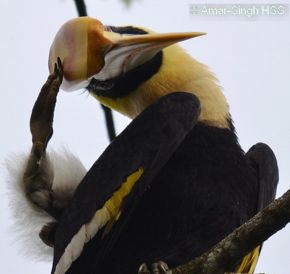“Went back to Taiping town with my wife to visit her family for Chinese New Year. Was expecting to spot some hornbills as her sister says that they visit her garden occasionally. Her home is located in a lush (many trees) housing estate near the Maxwell Hills – arguably one of the finest bird habitat/watching areas in Peninsular Malaysia. Still largely untouched hill where I have seen four species of hornbills and many other birds.
“We got there early at 8.30am, the light had still not come over hills and it was a bit dim. But almost immediately my wife spotted this adult male Great Hornbill (Buceros bicornis) (above) seated up in a Rain Tree (Samanea saman) preening (see video). My wife is one of the best spotters I know.
“Despite the low light I trusted my new Nikon D7000 to do the work (the sensor is great in low light) and was not disappointed.
“This adult male was magical and gave us extended views in many poses for 30 minutes. He allowed both of us to come directly under the tree. In the end we had to leave for the CNY visit but the bird remained. I took an excess of 250 images and having difficult throwing any away.
“Above-left shows close up of face and neck. Note the upper mandible is worn out on the inner surface from ?feeding. [Also, note the serrated edge of the mandibles.] Above-right shows the pose that won both our heart – he bent down to have a good look at us.
“The casque is fascinating with its broad flat top, ideal for ‘butting’ (above left). …It stops short at the back of the head, almost like a cap with hair sticking out. Although I expected the casque to be inert this adult took some time to scratch it (above right). Or else it was the foot that was itchy and it used the casque to rub the foot.
“The neck is very agile and extensible (above). Also a composite of the eye showing nictating membrane (below)
Habitat: Secondary growth/lush housing estate adjacent to large primary forest on hill range.
Red Data: Near Threatened
Dato’ Dr Amar-Singh HSS
Taiping, Perak, Malaysia
3rd February 2011


![HornbillGr ad-m [AmarSingh] - 1](https://besgroup.org/wp-content/uploads/HornbillGr-ad-m-AmarSingh-1.jpg)
![HornbillGr ad-m [AmarSingh] - 2](https://besgroup.org/wp-content/uploads/HornbillGr-ad-m-AmarSingh-2.jpg)
![HornbillGr ad-m [AmarSingh] - 4](https://besgroup.org/wp-content/uploads/HornbillGr-ad-m-AmarSingh-4.jpg)
![HornbillGr ad-m [AmarSingh] - 6](https://besgroup.org/wp-content/uploads/HornbillGr-ad-m-AmarSingh-6.jpg)
![HornbillGr ad-m [AmarSingh]a - 2](https://besgroup.org/wp-content/uploads/HornbillGr-ad-m-AmarSingha-2.jpg)

![HornbillGr ad-m [AmarSingh]a - 7 copy](https://besgroup.org/wp-content/uploads/HornbillGr-ad-m-AmarSingha-7-copy.jpg)
![HornbillGr ad-m [AmarSingh]a - 8](https://besgroup.org/wp-content/uploads/HornbillGr-ad-m-AmarSingha-81.jpg)







2 Responses
Fantastic documentation. Thanks for the post
I love the 4th picture of the Great Hornbill! Great shot. I often go to Khao Yai national park in Thailand and we see them actually every time, but every time I’m impressed by the size and the noise of the wings when it flies over the canopy.